This article was co-authored by wikiHow Staff. Our trained team of editors and researchers validate articles for accuracy and comprehensiveness. wikiHow's Content Management Team carefully monitors the work from our editorial staff to ensure that each article is backed by trusted research and meets our high quality standards.
This article has been viewed 46,716 times.
Learn more...
A wind rose is a circular diagram used to record data about wind speeds and frequencies over a specified period of time, which is handy if you want to know the average wind speeds for an area. When looking at a wind rose, you'll see it's constructed with spokes coming out from a center point that show the wind direction; each of the spokes are color-coded along their length to indicate the speed of the wind. The concentric circles on the wind rose look like a target, and each circle provides a measurement to help you figure out how long the wind blew at a certain speed.
Steps
Looking at the Key and Units
-
1Read the headline to find out the location. The location should be listed at the top or bottom of the diagram. The data for a wind rose is taken from one specific area, usually one weather station, and it will indicate where that location is in the heading information.[1]
-
2Pinpoint the time range in the heading to better interpret the data. Every wind rose covers a specific period of time, which differs from diagram to diagram. Find the date or time range listed on the diagram to see how much time the data covers. Check the title first, as that's where it's most likely to be.
- Often, it's listed as dates, such as March 19, 2018 to March 25, 2018. It can also cover much longer periods, such as 30 years or more.
- Sometimes, it may just cover a 24-hour period.
Advertisement -
3Identify the units for wind speed used on the diagram by checking the provided key. Find the square box within the larger diagram. It will have colored boxes and wind speeds listed next to it. These colors correspond to the colors on the spokes to tell you the wind speed. Check the unit to see if it's given in mph or kph.[2]
- In some cases, the key will give you extra information that you can use. For instance, it may tell you what percentage of time the winds are calm without you having to calculate it. It will also give you any units for the diagram you may be missing.[3]
-
4Find the units on each circle to understand how the data is presented. Each wind rose has a set of concentric circles. The circles represent how long the wind blew at certain speeds. Most often, the numbers are presented as percentages of the overall time, but sometimes, they are presented as hours or days.[4]
- Typically, the circles themselves are marked with the percentage or number of hours.
Establishing Wind Direction, Speed, and Frequency
-
1Read the wind rose like a compass to determine wind direction. Wind roses are set up in a circle, just like a compass. When looking at one, the top represents north, the right represents east, the left west, and the bottom south. As a "spoke" extends along one of these directions, that indicates the wind was blowing from that direction, not toward it.[5]
- For example, a spoke may extend upward toward the north, though it will be shaped like an arrow pointing toward the middle of the circle. In that case, the wind is blowing from the north toward the south.
- Some wheels just use 8 directions, north, south, east, west, northeast, northwest, southeast, and southwest. However, many use 16, adding north-northeast, east-northeast, and so on.
-
2Match the colors on each spoke to the key to determine how fast the wind gusted. Each spoke is divided into sections made up of different colors. The end of the spoke represents the fastest speeds, while the central point is the lowest. By checking it against the key, establish what speeds the wind blew at from that direction during the given time period, beginning with central point and working your way outward.[6]
- For instance, you may notice one spoke is green at the center and red at the end. After checking the key, you discover the green means the wind blew from 0 to 10 miles (16 km) and red means the wind gusted up to 40 to 45 miles (64 to 72 km) per hour. That means that within the given time period, the wind blew at speeds of 0 to 45 miles (72 km) per hour from that specific direction.
-
3Establish how long the wind blew at different speeds by examining the rings. As you move out from the center, the rings act like a tape measure. Each ring is marked with a different percentage or period of time. As you look at the spokes, use the rings to measure the length of each color-coded section. The length, based on the ring's measurements, tells you how long the wind blew at that speed.[7]
- For instance, if the color is purple, indicating on your particular map that it blew from the north at 15 to 25 miles (24 to 40 km) per hour, see where the color begins and ends along the rings within the spoke.
- If the purple area along the spoke starts at a smaller ring (10 percent according to the label) and ends at a larger ring (24 percent according to the label), then subtract 10 from 24, as that tells you what percentage of time the wind blew at that speed and direction, 14 percent.
- Usually, the central circle indicates calm conditions.[8]
-
4Calculate the percentage of time the wind blew at a certain speed. If you need to know how long the wind was at each speed, you can use the date(s) listed and the percentage you calculated from the spoke and rings to figure it out. Figure out how many hours or days the study covers by adding up the time between the dates or hours given, then calculate the percentage of that time period using the percentage from the previous step.
- For instance, say the study was over 16 days, from April 1st to April 16th. You noticed that the wind blew from the north at 15 to 25 miles (24 to 40 km) 14 percent of the time. Multiple the number of days by the percentage and then divide by 100: 16 x 14 = 224, 224 / 100 = 2.24 days.
- Some wind roses will have the circles already marked in days or hours so you don't have to calculate this number. Instead, just look at the numbers on the wheel and subtract them as you did with the percentage.
- For instance, maybe the largest circle is 30 hours and the next one is 20.
- If the color representing 30 to 35 miles (48 to 56 km) per hour moves from about halfway between the 2 circles (indicating 25 hours) to the 30 circle, then the wind spent 5 hours of time at this speed from that particular direction, as you subtract 25 from 30 hours.[9]
References
- ↑ https://www.meteoblue.com/en/weather/archive/windrose/reading_united-states-of-america_5207728
- ↑ https://www.meteoblue.com/en/weather/archive/windrose/reading_united-states-of-america_5207728
- ↑ https://www.wcc.nrcs.usda.gov/climate/windrose_ex.html
- ↑ https://www.meteoblue.com/en/weather/archive/windrose/reading_united-states-of-america_5207728
- ↑ http://www.bom.gov.au/climate/averages/wind/wind_rose.shtml
- ↑ https://www.meteoblue.com/en/weather/archive/windrose/reading_united-states-of-america_5207728
- ↑ https://www.meteoblue.com/en/weather/archive/windrose/reading_united-states-of-america_5207728
- ↑ http://www.bom.gov.au/climate/averages/wind/wind_rose.shtml
- ↑ https://www.meteoblue.com/en/weather/archive/windrose/reading_united-states-of-america_5207728
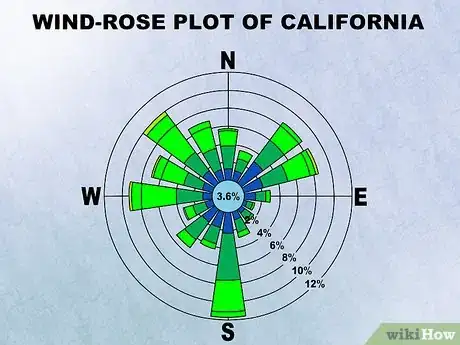
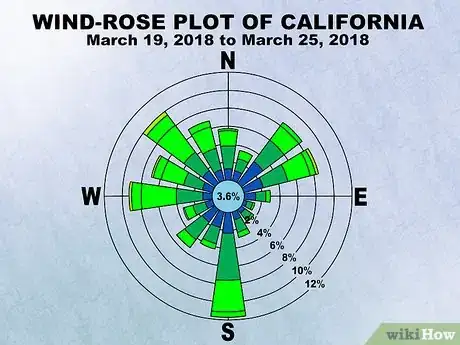
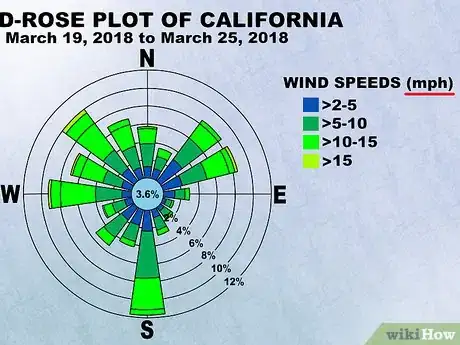
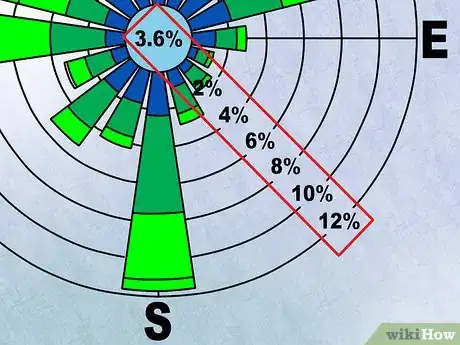
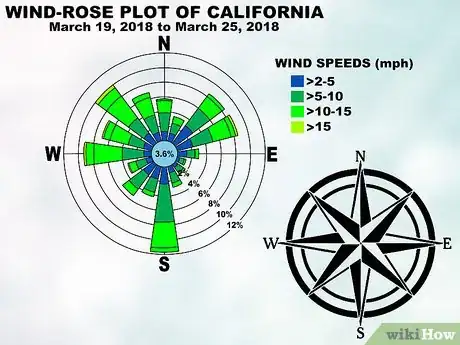
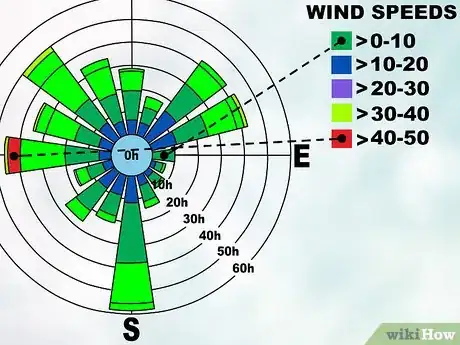
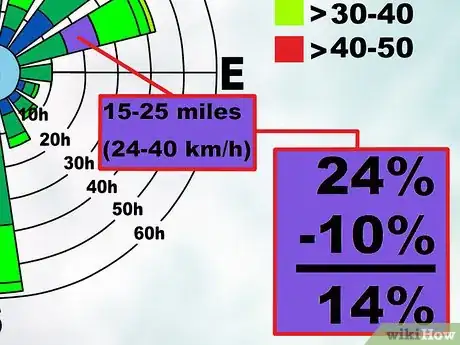
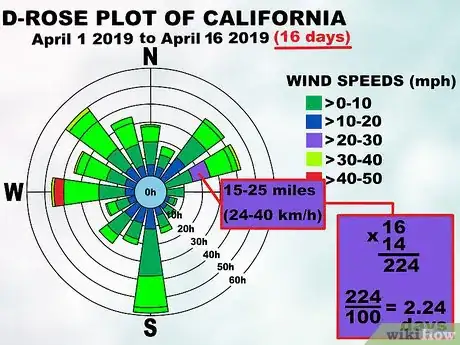









-Step-13.webp)

















































